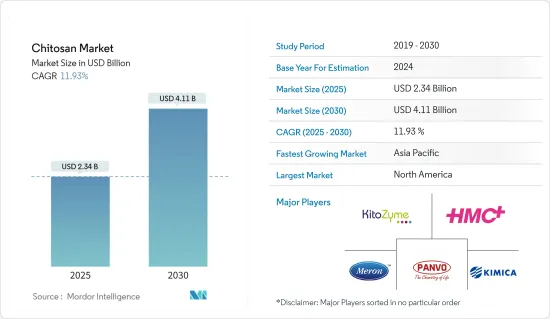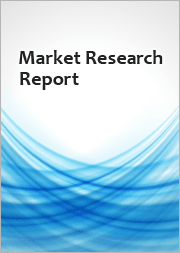
|
시장보고서
상품코드
1689850
세계의 키토산 시장 : 점유율 분석, 산업 동향 및 통계, 성장 예측(2025-2030년)Chitosan - Market Share Analysis, Industry Trends & Statistics, Growth Forecasts (2025 - 2030) |
||||||
세계의 키토산 시장 규모는 2025년 23억 4,000만 달러로 추정되며, 예측 기간 중(2025-2030년) CAGR 11.93%를 나타낼 전망이며, 2030년에는 41억 1,000만 달러에 달할 것으로 예측되고 있습니다.

이 시장은 그 궤적을 형성하는 몇 가지 중요한 요인에 의해 현저한 성장률을 경험하고 있습니다. 이러한 시장 성장 촉진요인은 수처리, 생물 의학, 제약 분야, 식품 및 식품 산업과 같은 산업에서 키토산의 용도가 확대되고 있음과 밀접하게 관련되어 있습니다.
시장을 형성하는 메가트렌드 지속가능하고 환경 친화적인 소재에 대한 주목 증가와 의료 요구 증가는 키토산 업계를 추진하는 주요 시장 메가트렌드입니다. 각 업계의 천연 소재에 대한 수요가 증가함에 따라 키토산 시장 포지션을 더욱 밀어 올립니다. 키토산의 다용도는 전 세계의 과제에 부합하며 환경 복구부터 건강 관리 혁신까지 다양한 분야에서 솔루션을 제공합니다.
수처리 활동 증가: 수질 관리는 세계적으로 중요한 과제가 되고 있으며, 효과적인 처리 솔루션에 대한 수요가 증가하고 있습니다. 키토산의 수산기와 아미노기에 의한 금속 이온 흡착 능력은 중금속 및 오일과 같은 오염 물질의 제거에 매우 효과적입니다. 키토산은 수처리에서 응집 보조제로서 널리 사용되고 있으며, 기존 응집제의 효과를 높이고 있습니다. 산화 그래핀/키토산 흡착제와 같은 복합재료는 폐수로부터 금속 이온을 제거하는데 매우 효과적인 것으로 밝혀졌습니다. 트리메틸키토산(TMC)을 비롯한 키토산 유도체와 같은 혁신은 담수원에서 시아노박테리아의 큰 발생과 같은 환경문제의 완화에 유망합니다.
바이오메디컬, 화장품, 식품 및 식품 산업에서의 제품 용도 확대: 키토산의 다용도는 다양한 산업에서의 채용으로 이어지고 있습니다. 시장 분석에 따르면, 키토산은 바이오메디컬 응용 분야에서 널리 사용되며 상처 코팅, 약물 전달, 조직 공학, 유전자 치료 등에 사용됩니다. 키토산의 항균성, 항산화성, 생체 접착성은 약물 전달 및 상처 치료에 효과적입니다. 암 치료에서는 키토산은 종양 부위에 축적하여 면역 반응을 유발함으로써 면역 요법을 강화합니다. 화장품은 키토산의 염증 반응과 감염을 예방하는 능력으로 스킨 케어 제제로 유용합니다. 식품업계에서 키토산은 식품첨가물과 항균제로 점점 더 많이 사용되고 있으며, 일본과 한국 등 주요 시장에서 승인을 받고 있습니다.
헬스케어 및 의료산업의 강력한 진보: 특히 약물전달나 조직공학 등 키토산의 독특한 특성을 살린 기술 혁신이 진행되고 있기 때문에 헬스케어 분야에서 키토산 시장 점유율이 상승하고 있습니다. 시장 분석에 의하면, 키토산을 베이스로 한 나노 입자는 특히 암 치료에 있어서, 표적을 좁힌 드러그 딜리버리를 진행하고 있습니다. 치과 분야에서 키토산 복합체는 세포 접착과 뼈 재생을 개선하고 치과 임플란트와 에나멜 보존에 새로운 가능성을 제공합니다. 키토산의 생체적합성은 조직 공학에서 점점 더 중요해지고 있으며, 피부, 뼈, 연골의 재생에 대한 응용이 일반적으로 되고 있습니다. 이러한 진보는 건강 관리에서 키토산의 역할 확대를 뒷받침합니다.
키토산 시장 동향
새우 유래 키토산 : 공급원을 석권
부문 개요 : 새우 유래 키토산은 여전히 시장의 핵심이며 키토산 시장 점유율의 42%를 차지합니다. 이 부문의 이점은 새우 키토산의 우수한 품질과 가용성으로 인한 것이며, 생물 의학, 수처리, 식품 보존 등의 분야에서 이용 가치가 높습니다.
성장의 원동력: 새우 유래의 키토산은 지속가능한 소재에 대한 세계 수요에 부합하며, 각 산업에서의 채용을 촉진하고 있습니다. 특히 아시아태평양에서 양식산업의 성장으로 원료의 안정공급이 확보되는 한편, 생물의학이나 환경관리에 응용을 목적으로 한 고품질 키토산 수요는 증가의 길을 따라가고 있습니다.
경쟁 구도 : 시장 리더와 기업은 새우 기원의 키토산의 우위를 유지하기 위해 수직 통합 전략을 채택합니다. 또한 추출기술의 혁신도 중요한 차별화 요인이며, 각 회사는 키토산의 품질과 순도를 높이는 데 주력하고 있습니다. 새우 양식이 환경에 미치는 영향을 줄이기 위해 지속 가능한 양식 방법이 개발되었으며, 이 분야에서의 지속적인 성장, 시장 점유율 확대 및 리더십이 확보되고 있습니다.
아시아태평양: 키토산 시장 성장의 진원지
지역 역학: 아시아태평양은 세계의 키토산 시장에서 가장 급성장하고 있는 부문으로 두드러지며, 2024년부터 2029년까지 CAGR 12.38%로 확대될 것으로 예측되고 있습니다. 급속한 산업화, R&D 투자, 키토산 용도의 인지도 향상은 APAC 지역 시장 성장을 이끌고 있습니다.
성장 촉매 : 중국과 인도와 같은 국가에서의 제약 및 바이오 메디컬 산업의 성장과 건강 관리 인프라 투자 증가는 시장 성장의 주요 촉진요인이 되었습니다. 급속히 발전하고 있는 이들 국가에서는 고급 수처리 솔루션에 대한 요구가 커지고 있으며, 키토산의 용도도 확대되고 있습니다. 게다가 화장품과 식품의 천연 성분에 대한 소비자의 선호도가 높아지면서 이러한 산업에서의 키토산 수요가 증가하고 있습니다.
전략적 과제: 업계 각사는 다양한 아시아태평양 시장에 진출하기 위해 현지에서의 파트너십과 유통망 구축에 주력하고 있습니다. 기업은 또한 일본과 한국 등의 국가에 R&D 센터를 설립하여 이 지역에 특화된 제품을 개발하고 있습니다. 아시아의 복잡한 규제 상황을 극복하고 지속가능성에 대한 우려를 다루는 것은 장기적인 성공에 필수적입니다.
키토산 산업 개요
시장 특징 세분화된 시장에서 다양한 기업
이 세계 시장은 매우 단편화되어 있으며 대기업과 함께 많은 중소기업이 존재합니다. Panvo Organics Pvt. Ltd, KitoZyme LLC, KIMICA Corporation 등 기업이 주목할만한 기업이며, 각각 다른 키토산 기반 제품을 전문으로 하고 있습니다.
시장 리더: 혁신과 다각화가 성공의 원동력
Dainichiseika Color & Chemicals Mfg Co. Ltd과 KIMICA Corporation 등 주요 시장 리더는 기술 혁신과 다양화로 탁월합니다. 이러한 기업들은 새로운 키토산의 용도를 발견하기 위해 연구 개발에 많은 투자를 하고 있으며, 다양한 산업의 요구에 부응하기 위해 제품 포트폴리오의 확대에 주력하고 있습니다. 지속가능성과 고품질 생산 공정에 대한 헌신은 경쟁 구도에서 두드러진 존재감을 보여줍니다.
미래 성공을 위한 전략 조사, 지속가능성, 시장 확대
향후 시장에서의 성공은 신규의 생물의학 및 의약품 용도를 발견하기 위한 연구개발 노력의 강화에 달려 있습니다. 기업은 지속가능한 생산방법에 주력하고 키토산 추출과 관련된 환경문제를 다루어야 합니다. 신흥 시장, 특히 아시아태평양 시장으로의 진출은 전략적으로 필수적입니다. 지역별 제품 개발과 함께 현지에서의 파트너십은 향후 수년간 시장 개척의 원동력이 될 것으로 보입니다.
기타 혜택:
- 엑셀 형식 시장 예측(ME) 시트
- 3개월간의 애널리스트·지원
목차
제1장 서론
- 조사의 전제조건과 시장 정의
- 조사 범위
제2장 조사 방법
제3장 주요 요약
제4장 시장 역학
- 시장 개요
- 시장 성장 촉진요인
- 수처리 활동의 활성화
- 바이오메디컬, 화장품, 식품 및 식품 산업에서의 제품 용도 확대
- 헬스케어/메디컬 업계에 있어서의 강력한 진보
- 시장 성장 억제요인
- 규제 프레임워크
- Porter's Five Forces 분석
- 신규 참가업체의 위협
- 구매자/소비자의 협상력
- 공급기업의 협상력
- 대체품의 위협
- 경쟁 기업간 경쟁 관계의 강도
제5장 시장 세분화
- 공급원별
- 쉬림프
- 프론
- 게
- 기타 소스
- 용도별
- 수처리
- 화장품
- 의약품 및 바이오메디컬
- 식음료
- 기타 용도
- 지역
- 북미
- 미국
- 캐나다
- 멕시코
- 유럽
- 독일
- 영국
- 프랑스
- 이탈리아
- 스페인
- 기타 유럽
- 아시아태평양
- 중국
- 일본
- 인도
- 호주
- 한국
- 기타 아시아태평양
- 중동 및 아프리카
- GCC
- 남아프리카
- 기타 중동 및 아프리카
- 남미
- 브라질
- 아르헨티나
- 기타 남미
- 북미
제6장 경쟁 구도
- 기업 프로파일
- Panvo Organics Pvt Ltd
- GTC Bio Corporation
- Dupont Corporation
- KitoZyme SA
- KIMICA Corporation
- Dainichiseika Color & Chemicals Mfg Co. Ltd
- Heppe Medical Chitosan GmbH
- Meron Biopolymers
- Qingdao Yunzhou
- Biophrame Technologies
- ChitoTech
- Marshal Marine
- BIO21 Co. Ltd
- Austanz Chitin Pty Ltd
- KiOmed Pharma
제7장 시장 기회와 앞으로의 동향
JHS 25.04.07The Chitosan Market size is estimated at USD 2.34 billion in 2025, and is expected to reach USD 4.11 billion by 2030, at a CAGR of 11.93% during the forecast period (2025-2030).

It is experiencing a significant growth rate, driven by several key factors shaping its trajectory. These market drivers are closely tied to the expanding applications of chitosan across industries like water treatment, biomedical, pharmaceutical sectors, and the food and beverage industry.
Megatrends Shaping the Market: Increasing focus on sustainable, eco-friendly materials and growing healthcare needs are key mega market trends propelling the Chitosan industry. Rising demand for natural ingredients across industries further boosts Chitosan's market position. Chitosan's versatility aligns with global challenges, offering solutions in sectors ranging from environmental remediation to healthcare innovation.
Rising Water Treatment Activities: Water quality management is becoming a critical concern globally, driving demand for effective treatment solutions. Chitosan's ability to adsorb metal ions due to its hydroxyl and amino groups makes it highly effective in removing contaminants like heavy metals and oils. Chitosan is widely used as a coagulant aid in water treatment, enhancing the effectiveness of traditional coagulants. Composite materials, such as graphene oxide/chitosan adsorbents, are emerging as highly effective in removing metal ions from wastewater. Innovations like chitosan derivatives, including trimethyl chitosan (TMC), show promise in mitigating environmental issues, such as cyanobacterial blooms, in freshwater sources.
Growing Product Application in Biomedical, Cosmetics, and Food and Beverage Industries: Chitosan's versatility has led to its adoption in various industries. Market analysis highlights its widespread use in biomedical applications, within which, it is used for wound dressing, drug delivery, tissue engineering, and gene therapy. Chitosan's antibacterial, antioxidant, and bio adhesive properties make it effective for drug delivery and wound care. In cancer therapy, chitosan enhances immunotherapy by accumulating at tumor sites, triggering immune responses. In cosmetics, chitosan's ability to prevent inflammatory reactions and infections makes it valuable in skin care formulations. In the food industry, chitosan is increasingly used as a food additive and antimicrobial agent, with approvals in key markets such as Japan and Korea.
Strong Advancements in Healthcare and Medical Industry: The market share of chitosan is rising in healthcare sector as the sector is innovating around chitosan's unique properties, particularly in drug delivery and tissue engineering. Market analysis reveals that Chitosan-based nanoparticles are advancing targeted drug delivery, especially in cancer treatments. In dentistry, chitosan composites improve cell adhesion and bone regeneration, offering new possibilities in dental implants and enamel preservation. Chitosan's biocompatibility is increasingly important in tissue engineering, with applications in skin, bone, and cartilage regeneration becoming more common. These advancements underscore Chitosan's growing role in healthcare.
Chitosan Market Trends
Shrimp-Derived Chitosan: Dominating the Source Landscape
Segment Overview: Shrimp-derived chitosan remains the cornerstone of the market, commanding 42% of the chitosan market share. This segment's dominance is driven by the superior quality and availability of shrimp chitosan, making it valuable across sectors like biomedical, water treatment, and food preservation.
Growth Drivers: Shrimp-derived chitosan aligns with the global demand for sustainable materials, driving its adoption across industries. The growing aquaculture industry, particularly in Asia-Pacific, ensures a steady supply of raw materials, while the demand for high-quality chitosan for applications in biomedicine and environmental management continues to rise.
Competitive Landscape: Market leaders and players are adopting vertical integration strategies to maintain their dominance in shrimp-derived chitosan. Innovations in extraction techniques are also key differentiators, with companies focusing on increasing chitosan quality and purity. Sustainable farming practices are being developed to mitigate the environmental impact of shrimp aquaculture, ensuring continued growth, rising market share and leadership in this segment.
Asia-Pacific: The Epicenter of Chitosan Market Growth
Regional Dynamics: Asia-Pacific stands out as the fastest-growing segment in the global chitosan market, with a projected CAGR of 12.38% between 2024 and 2029. Rapid industrialization, R&D investments, and increasing awareness of chitosan applications are driving the regional APAC market growth.
Growth Catalysts: The booming pharmaceutical and biomedical industries in countries like China and India, alongside growing investments in healthcare infrastructure, are key market growth drivers. The need for advanced water treatment solutions in these rapidly developing nations is also expanding Chitosan's applications. Additionally, the rising consumer preference for natural ingredients in cosmetics and food is boosting chitosan demand in these industries.
Strategic Imperatives: Industry players are focusing on building local partnerships and distribution networks to penetrate diverse Asia-Pacific markets. Companies are also establishing R&D centers in countries like Japan and South Korea to develop region-specific products. Navigating Asia's complex regulatory landscape and addressing sustainability concerns are essential for long-term success.
Chitosan Industry Overview
Market Characteristics: Diverse Players in a Fragmented Market
This global market is highly fragmented, with numerous small to medium-sized enterprises alongside larger corporations. Companies like Panvo Organics Pvt. Ltd, KitoZyme LLC, and KIMICA Corporation are notable players, each specializing in different Chitosan-based products.
Market Leaders: Innovation and Diversification Drive Success
Key market leaders, such as Dainichiseika Color & Chemicals Mfg Co. Ltd and KIMICA Corporation, excel through innovation and diversification. These companies invest heavily in R&D to discover new chitosan applications and focus on expanding their product portfolios, catering to various industry needs. Their commitment to sustainability and high-quality production processes sets them apart in the competitive landscape.
Strategies for Future Success: Research, Sustainability, and Market Expansion
Future market success will depend on intensifying R&D efforts to discover novel biomedical and pharmaceutical applications. Companies must focus on sustainable production methods, addressing environmental concerns associated with chitosan extraction. Expanding into emerging markets, particularly in Asia-Pacific, is a strategic imperative. Local partnerships, coupled with region-specific product development, will drive market growth in the coming years.
Additional Benefits:
- The market estimate (ME) sheet in Excel format
- 3 months of analyst support
TABLE OF CONTENTS
1 INTRODUCTION
- 1.1 Study Assumptions and Market Definition
- 1.2 Scope of the Study
2 RESEARCH METHODOLOGY
3 EXECUTIVE SUMMARY
4 MARKET DYNAMICS
- 4.1 Market Overview
- 4.2 Market Drivers
- 4.2.1 Rising Water Treatment Activities
- 4.2.2 Growing Product Application in the Biomedical, Cosmetics, and Food and Beverage Industries
- 4.2.3 Strong Advancements in the Healthcare/Medical Industry
- 4.3 Market Restraints
- 4.3.1 Regulatory Framework
- 4.4 Porter's Five Forces Analysis
- 4.4.1 Threat of New Entrants
- 4.4.2 Bargaining Power of Buyers/Consumers
- 4.4.3 Bargaining Power of Suppliers
- 4.4.4 Threat of Substitute Products
- 4.4.5 Intensity of Competitive Rivalry
5 MARKET SEGMENTATION (Market Size by Value - USD)
- 5.1 By Source
- 5.1.1 Shrimps
- 5.1.2 Prawns
- 5.1.3 Crabs
- 5.1.4 Other Sources
- 5.2 By Application
- 5.2.1 Water treatment
- 5.2.2 Cosmetics
- 5.2.3 Pharmaceutical and Biomedical
- 5.2.4 Food and Beverage
- 5.2.5 Other Applications
- 5.3 Geography
- 5.3.1 North America
- 5.3.1.1 United States
- 5.3.1.2 Canada
- 5.3.1.3 Mexico
- 5.3.2 Europe
- 5.3.2.1 Germany
- 5.3.2.2 United Kingdom
- 5.3.2.3 France
- 5.3.2.4 Italy
- 5.3.2.5 Spain
- 5.3.2.6 Rest of Europe
- 5.3.3 Asia-Pacific
- 5.3.3.1 China
- 5.3.3.2 Japan
- 5.3.3.3 India
- 5.3.3.4 Australia
- 5.3.3.5 South Korea
- 5.3.3.6 Rest of Asia-Pacific
- 5.3.4 Middle-East and Africa
- 5.3.4.1 GCC
- 5.3.4.2 South Africa
- 5.3.4.3 Rest of Middle-East and Africa
- 5.3.5 South America
- 5.3.5.1 Brazil
- 5.3.5.2 Argentina
- 5.3.5.3 Rest of South America
- 5.3.1 North America
6 COMPETITIVE LANDSCAPE
- 6.1 Company Profiles
- 6.1.1 Panvo Organics Pvt Ltd
- 6.1.2 GTC Bio Corporation
- 6.1.3 Dupont Corporation
- 6.1.4 KitoZyme SA
- 6.1.5 KIMICA Corporation
- 6.1.6 Dainichiseika Color & Chemicals Mfg Co. Ltd
- 6.1.7 Heppe Medical Chitosan GmbH
- 6.1.8 Meron Biopolymers
- 6.1.9 Qingdao Yunzhou
- 6.1.10 Biophrame Technologies
- 6.1.11 ChitoTech
- 6.1.12 Marshal Marine
- 6.1.13 BIO21 Co. Ltd
- 6.1.14 Austanz Chitin Pty Ltd
- 6.1.15 KiOmed Pharma



















